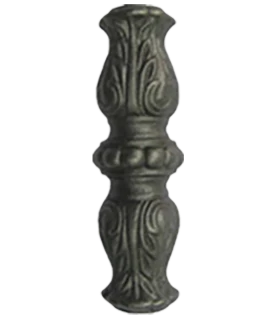Beautiful Iron Elements Perfect for Finishing Railings and Fences Creatively
The Beauty and Functionality of Decorative Cast Iron in Railings and Fences
When it comes to enhancing the aesthetic and functional aspects of outdoor spaces, few materials can rival the charm and durability of decorative cast iron. From majestic railings that frame staircases to elegant fences that define property lines, cast iron elements serve as ideal finishing touches that elevate any structure. The allure of decorative cast iron lies not only in its classic beauty but also in its ability to withstand the test of time, making it a popular choice for homeowners and designers alike.
The Timeless Appeal of Cast Iron
Cast iron has a rich historical significance, often associated with ornate designs that hark back to Victorian and Edwardian eras. Its detailed craftsmanship lends an air of sophistication to any architectural project. Decorative cast iron elements can be found in various forms, including balusters, finials, and decorative scrollwork. Each piece tells a story, often reflecting the artistry and craftsmanship prevalent during its period of manufacture.
The intricate designs allow homeowners to express their individuality, making each railing or fence a unique embodiment of aesthetic taste. Whether one prefers the elaborate flourishes of Victorian style or the simplicity of a modern minimalist approach, decorative cast iron can be tailored to suit a variety of design sensibilities.
Durability and Strength
Beyond its visual appeal, decorative cast iron is renowned for its strength and durability. Unlike other materials such as wood, which can warp, rot, or require frequent maintenance, cast iron remains robust under various environmental conditions. It is resistant to rust when properly coated, ensuring that both its beauty and structural integrity are maintained over time. This durability makes it an ideal material for both railings and fences that are exposed to the elements year-round.
decorative cast iron or iron elements are ideal for ending or completing the railing or fences.

The heavy weight of cast iron also adds a level of security that lighter materials cannot provide. Fences constructed from iron deter unwanted intrusions and provide a sense of safety, making them an excellent investment for homeowners. Furthermore, railings made from cast iron can offer a similar sense of security, preventing accidents while providing an elegant frame for staircases, balconies, or decks.
Versatility in Design
Another significant advantage of decorative cast iron elements is their versatility. They can be easily integrated into existing structures or used to create new designs that harmonize with the surrounding environment. Whether it’s a traditional home or a contemporary building, decorative cast iron can adapt and enhance the overall aesthetic.
Craftsmen are now combining cast iron with other materials like wood or glass, creating hybrid designs that emphasize both strength and visual appeal. For instance, a wrought iron fence can be paired with wooden posts for a rustic charm, while a balcony railing can incorporate glass panels with cast iron accents to achieve a modern look. This versatility makes cast iron a favored choice among architects and designers aiming for innovation while respecting traditional aesthetics.
Conclusion
In conclusion, decorative cast iron or iron elements provide an ideal way to finish or complete railings and fences, marrying beauty with functionality. Their timeless appeal, unmatched durability, and versatility in design make them an excellent investment for any outdoor space. As homeowners increasingly seek to define their properties with elegance and security, decorative cast iron stands out as a quintessential choice, enriching both traditional and contemporary settings. Whether for practical use or aesthetic enhancement, the seamless integration of decorative cast iron will undoubtedly continue to influence the architectural landscape for years to come.
-
Wrought Iron Components: Timeless Elegance and Structural StrengthNewsJul.28,2025
-
Window Hardware Essentials: Rollers, Handles, and Locking SolutionsNewsJul.28,2025
-
Small Agricultural Processing Machines: Corn Threshers, Cassava Chippers, Grain Peelers & Chaff CuttersNewsJul.28,2025
-
Sliding Rollers: Smooth, Silent, and Built to LastNewsJul.28,2025
-
Cast Iron Stoves: Timeless Heating with Modern EfficiencyNewsJul.28,2025
-
Cast Iron Pipe and Fitting: Durable, Fire-Resistant Solutions for Plumbing and DrainageNewsJul.28,2025
-
 Wrought Iron Components: Timeless Elegance and Structural StrengthJul-28-2025Wrought Iron Components: Timeless Elegance and Structural Strength
Wrought Iron Components: Timeless Elegance and Structural StrengthJul-28-2025Wrought Iron Components: Timeless Elegance and Structural Strength -
 Window Hardware Essentials: Rollers, Handles, and Locking SolutionsJul-28-2025Window Hardware Essentials: Rollers, Handles, and Locking Solutions
Window Hardware Essentials: Rollers, Handles, and Locking SolutionsJul-28-2025Window Hardware Essentials: Rollers, Handles, and Locking Solutions -
 Small Agricultural Processing Machines: Corn Threshers, Cassava Chippers, Grain Peelers & Chaff CuttersJul-28-2025Small Agricultural Processing Machines: Corn Threshers, Cassava Chippers, Grain Peelers & Chaff Cutters
Small Agricultural Processing Machines: Corn Threshers, Cassava Chippers, Grain Peelers & Chaff CuttersJul-28-2025Small Agricultural Processing Machines: Corn Threshers, Cassava Chippers, Grain Peelers & Chaff Cutters












